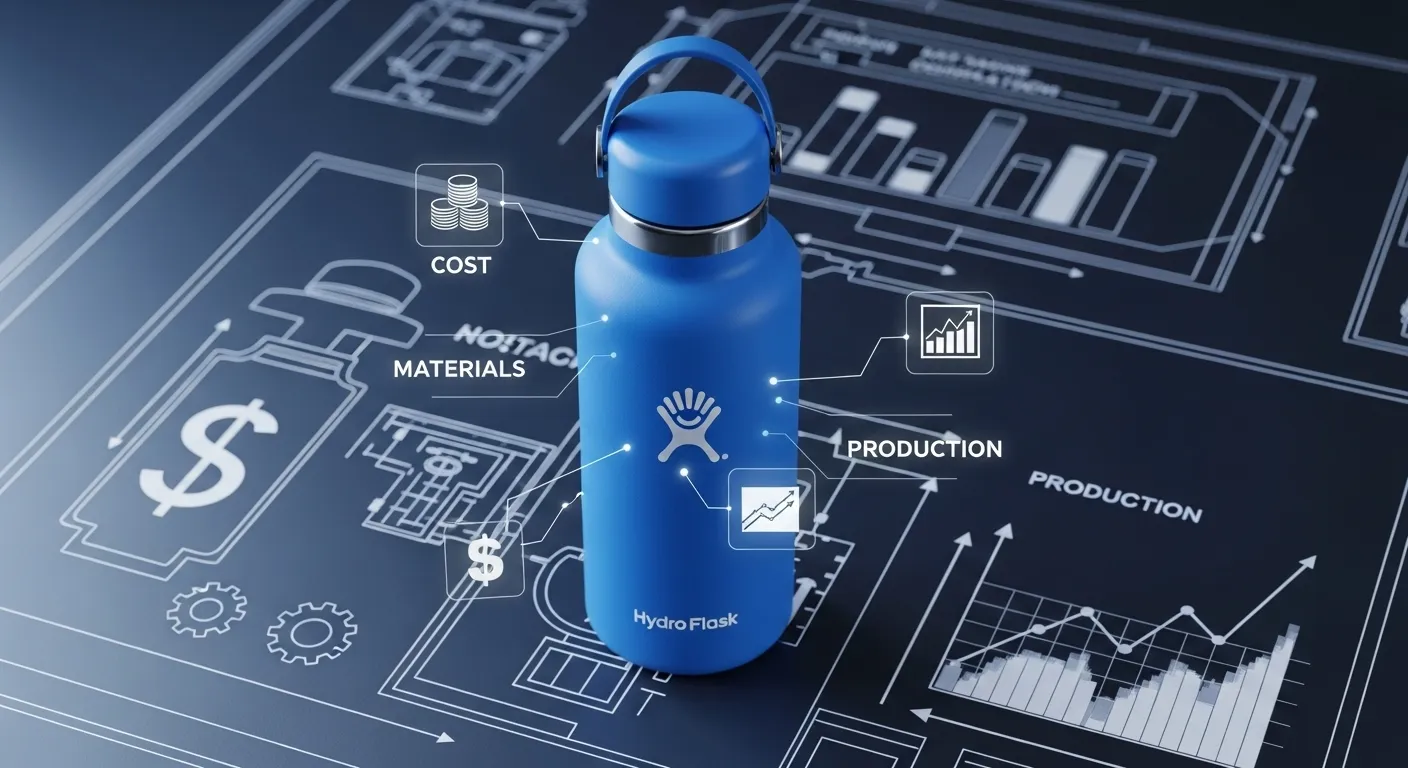
Wonder why Hydro Flask bottles cost so much? Let's break down what it really costs to make one.
The estimated manufacturing cost of a 32 oz Hydro Flask is between $4.30 and $4.70, while the retail price ranges from $30 to $50.
Keep reading to learn what goes into that price and why it matters.
What materials and manufacturing processes are involved in making a Hydro Flask?
Materials make the bottle, tech keeps it premium.
Hydro Flask uses 18/8 stainless steel1, double-wall vacuum sealing2, and powder coating3 for durability and style.
Key Manufacturing Steps
- Stainless steel pipe cutting
- Inner and outer wall shaping
- TempShield vacuum insulation
- Sealing without lead
- Powder coating for grip and color
Robotic arms automate much of the work, lowering labor costs and improving precision.
How much does it cost to produce a single Hydro Flask bottle?
It's cheaper than you think.
A 32 oz Hydro Flask bottle costs between $4.30 and $4.70 to produce in bulk, FOB Shanghai4.
Cost Breakdown Table
| Component | Estimated Cost (USD) |
|---|---|
| Raw stainless steel | $1.50 - $2.00 |
| Labor | $1.00 - $1.50 |
| Factory overhead | ~$0.50 |
| Powder coating | ~$0.40 |
| Packaging | $0.10 - $0.20 |
| Total | $4.30 - $4.70 |
This doesn't include marketing, warehousing, or retail distribution costs.
What factors influence the manufacturing cost of Hydro Flask bottles?
Every step adds up.
Costs are driven by materials, labor, equipment, finishing processes, packaging, and shipping logistics.
Major Influences
- Material: 18/8 stainless steel is high-quality and food-safe5.
- Labor: Automation reduces costs but doesn't eliminate skilled labor needs.
- Finishing: Powder coating adds protection and style.
- Volume: Larger orders get better rates on materials and transport.
Customization also changes the price tag.
How does Hydro Flask's manufacturing cost compare to its retail price?
Big gap, bigger brand value.
Retail prices for a 32 oz Hydro Flask range from $30 to $50, about 7 to 10 times its manufacturing cost.
Why the Markup?
- Branding and positioning as a premium lifestyle item
- Retail and wholesale margins
- Packaging and design costs
- Warranty and customer service
- Marketing and sponsorship expenses
This isn't just about function—it's about perception.
What role do labor, materials, and overhead play in the total production cost?
Raw materials lead, labor follows.
Raw materials make up 35–45% of costs; labor 20–30%; overhead about 10–15%.
Cost Composition Table
| Cost Element | Approximate % of Total Cost |
|---|---|
| Stainless steel | 40% |
| Labor | 25% |
| Overhead | 10% |
| Finishing | 15% |
| Packaging | 5% |
| Miscellaneous | 5% |
Efficient processes keep these ratios stable across orders.
How does customization or coating affect the cost of Hydro Flask bottles?
It adds flair—and cost.
Powder coating adds ~$0.40 per unit6; complex designs increase setup costs.
Types of Customization
- Powder coat finish: Durable, matte, adds color
- Laser engraving: For logos or branding
- Custom lids or packaging: Adds branding impact
Each adds time, materials, and labor.
What are the logistics and shipping costs associated with Hydro Flask production?
Shipping varies with distance and volume.
Shipping is often included in FOB prices from China but fluctuates with freight rates and volume.
Shipping Considerations
- FOB Shanghai: Seller handles costs up to port
- Ocean freight: Cheapest for bulk orders
- Air freight: Faster but more expensive
- Fuel surcharges and customs: Add variability
Planning ahead reduces shipping surprises.
How does Hydro Flask maintain quality while controlling manufacturing costs?
Automation is the answer.
Hydro Flask uses robotic manufacturing and proprietary sealing tech7 (TempShield) to ensure consistency without lead.
Efficiency Meets Quality
- Robotic assembly reduces human error
- Pressure-tested for insulation performance
- Powder coating ensures grip and scratch resistance
- Rigorous QC for leak prevention and uniformity
It's why they offer lifetime warranties.
What profit margins does Hydro Flask likely achieve on each bottle?
They're strong—very strong.
Estimated profit margins range from 70% to 85%, depending on channel and pricing.
Margin Breakdown Example
| Element | Value (USD) |
|---|---|
| Production Cost | ~$4.50 |
| Retail Price | ~$39.95 |
| Gross Margin | ~$35.45 |
| Gross Margin % | ~88% |
Distribution, marketing, and retail cut into this, but margins stay high.
How do manufacturing costs of Hydro Flask compare to other stainless steel water bottles?
Similar bottle, different price.
Manufacturing costs are similar across brands ($2–$5/unit), but Hydro Flask's branding allows for premium pricing.
Comparison Table
| Brand | Manufacturing Cost | Average Retail Price | Notes |
|---|---|---|---|
| Hydro Flask | $4.30 - $4.70 | $30 - $50 | Premium branding |
| Generic OEM | $2.50 - $3.50 | $10 - $20 | Similar quality, less marketing |
| YETI | $5.00 - $6.00 | $35 - $60 | Heavier, rugged design |
Brand equity shapes consumer value perception more than raw cost.
Conclusion
Hydro Flask bottles cost around $4.50 to make, but branding, quality, and smart marketing let them sell for up to 10 times that.
FAQs
Why is Hydro Flask so expensive if it costs under $5 to make?
Branding, quality, warranties, and marketing justify the higher price.
Are Hydro Flask bottles really made in China?
Yes, most production is based in China due to manufacturing efficiency.
Does Hydro Flask use lead in its vacuum seal?
No, it uses a proprietary lead-free TempShield seal.
How can other brands offer similar bottles at lower prices?
They may cut costs on materials, QC, or branding.
Can I create a similar bottle for my brand?
Yes. With OEM factories, you can customize and produce bottles starting from $2.50–$5 each in bulk.
-
This comprehensive guide from MightyNest explains the composition and properties of 18/8 stainless steel (also known as 304 grade), detailing how its 18% chromium and 8% nickel content provides food-safe corrosion resistance and durability ideal for water bottles. ↩
-
This detailed manufacturing resource from KingStar describes the vacuum insulation process step-by-step, including how inner and outer stainless steel walls are formed, welded, and evacuated to create the insulation layer that keeps beverages hot or cold for extended periods. ↩
-
This technical article explains the powder coating process for stainless steel bottles, including surface preparation, electrostatic powder application, and high-temperature curing that creates the durable, scratch-resistant, and colorful exterior finish on premium water bottles. ↩
-
This complete guide to FOB (Free on Board) shipping terms explains that FOB Shanghai means the seller covers all costs until goods are loaded onto the ship in Shanghai, after which the buyer assumes responsibility—a common pricing structure for Chinese manufacturing. ↩
-
This Dixon Valve resource explains food-grade stainless steel standards, including why 18/8 stainless steel's non-porous surface, corrosion resistance, and FDA-compliant properties make it the preferred material for food and beverage contact applications. ↩
-
This industry article from Nanobot Solutions details the advantages of powder coating on stainless steel bottles, including durability, scratch resistance, environmental benefits, and cost-effectiveness, explaining why it adds approximately $0.40-0.50 per unit to manufacturing costs. ↩
-
This Packshine manufacturing overview describes how modern vacuum insulated bottle production uses robotic assembly lines, automated welding, temperature testing, and quality control processes to maintain consistency while controlling labor costs and ensuring leak-proof performance. ↩

